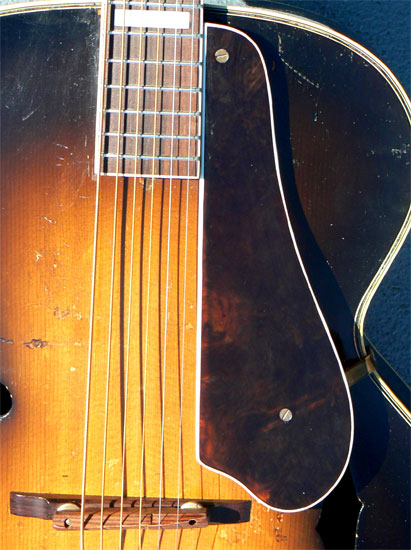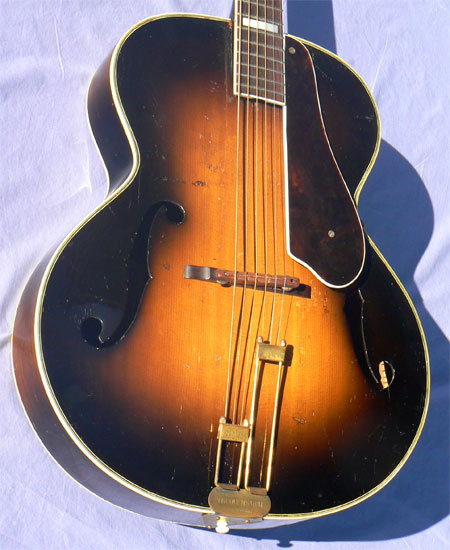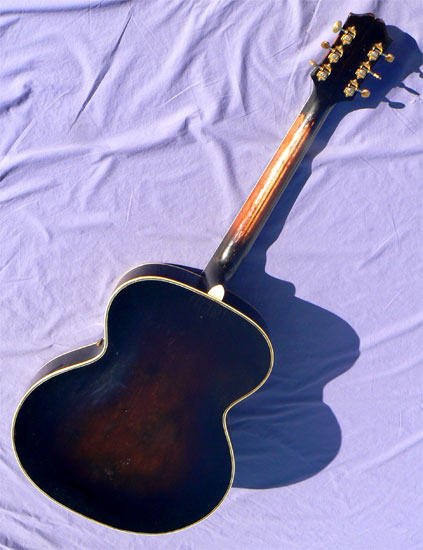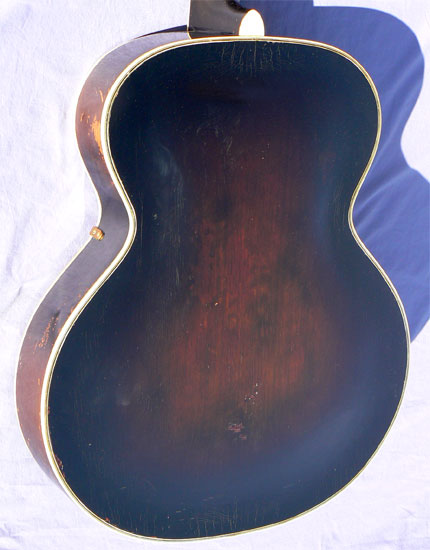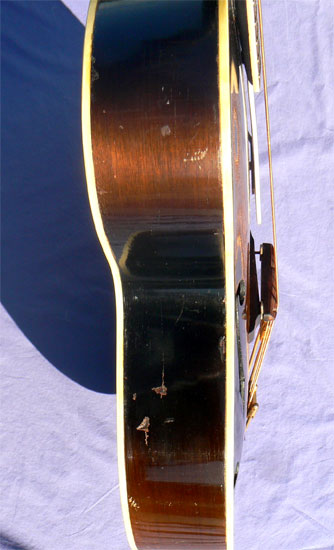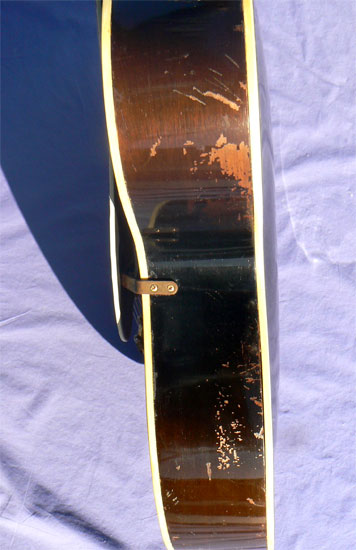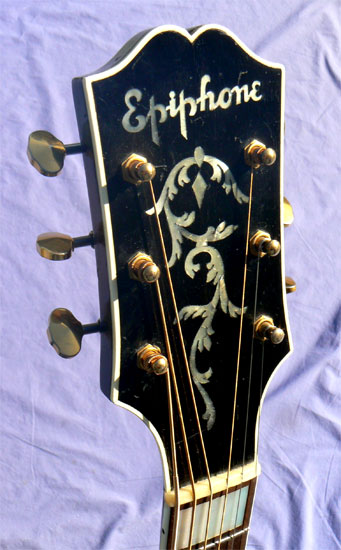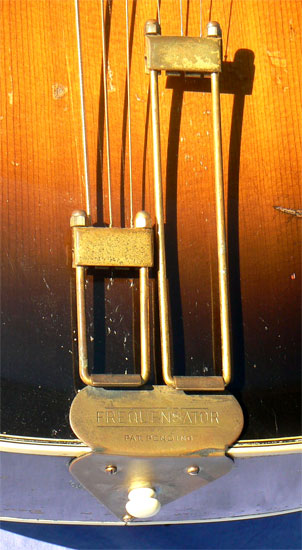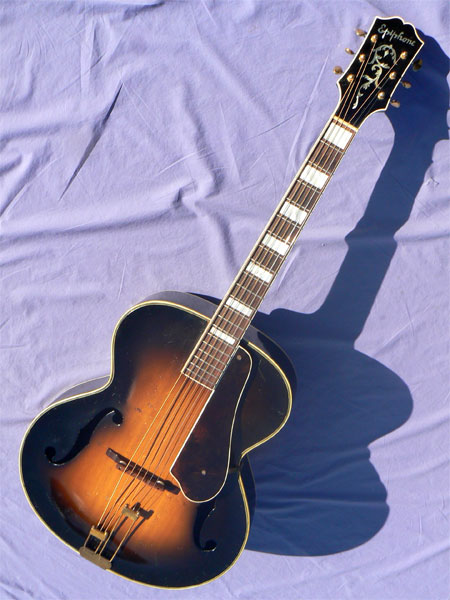 , Walnut Body
, Walnut BodyHome / Instruments /Accessories / Ordering / Tips / Friends
archtop.com
1939 Epiphone Broadway , Walnut Body
, Walnut Body
Status: Pricing and hold status for all instruments currently available is shown on our Instruments page here. If this instrument does not appear on the Instruments page it has been sold, and is no longer available. Photos and descriptions of Previously Sold instruments may by found here. To be notified of examples of this model or similar instruments in the future, please contact [email protected],. Please be specific on which instrument(s) you're looking for, and we'll be happy to contact you as soon as they become available.
Serial # 14768, Masterbilt label. Body size at lower bout: 17 3/8" Scale length: 25 1/2". Nut width: 1 3/4" Neck depth,1st/10th frets: .87/1.00
Materials: Solid handcarved figured black walnut back and sides; solid bookmatched handcarved spruce top; Honduras mahogany neck with 3-ply walnut/maple centerstripe; mother of pearl block style fingerboard inlay; ornate vine style mother-of-pearl peghead inlay, triple bound body; bound fingerboard and headstock.
Hardware: Original hardware includes gold Frequensator tailpiece, adjustable Brazilian rosewood bridge, bound tortoise pickguard, adjustable truss rod. Gold Waverly 16x1 scalloped open-back tuners.
Notes: Alone among major builders, the Epiphone Company produced it's upscale Broadway model with back and sides of solid black walnut, beginning in 1932. The result was a guitar with unusually attractive looks, but more. The voice of these guitars is absolutely unique among acoustic jazz guitars. The hard, thin walnut back and sides produce a tone that is distinctly more brilliant than ordinary maple bodies.
Upsized from the 16" body of the early 30's, the 17" version of the walnut Broadway was produced for less than four years, between 1936 and the early months of 1940. Delicate, cello-shaped f-holes made their debut in this version, replacing the segmented holes of earlier models. The vine headstock inlay and block fingerboard markers in mother-of-pearl lend the guitar a look of understated elegance.
The neck profile on Epis of this era is particularly slim and contemporary, and free of the clubbiness found in many prewar guitars. Virtually all walnut Broadways were built with the asymmetrical 'Masterbilt' headstock design, but not all. In 1940, Epiphone redesigned their pegheads with a center-dip design, and changed the body on the Broadway from walnut to maple. This rare transitional example from early 1940 has the older body with the newer peghead, and is one of the very few we've ever seen.
Featherlight in construction, the instrument weighs in at an astonishing 5lb. 2oz. Not merely a conversation piece, this guitar has a particularly outstanding voice, with unusually brilliant ringing tone, and wide open volume. Not to mention a wonderful medium profile neck so beloved by modern players. A rare original bound tortoise pickguard remains in superb condition, the binding is tight and sound, and the original gold Frequensator tailpiece is fully intact. The original sunburst finish is in good shape overall, showing a few touchups on top and a few patches of knee and case wear on the bass side.
The original deep sunburst on the back has been protected with a light dusting of true vintage nitrocellulose lacquer. Finally, the guitar has been equipped with vintage correct gold Waverly scalloped 16x1 tuners (the most costly machines available), fresh pro frets for smooth low action, and is fitted in a fine plush lined hardshell case.
A handsome instrument with a vibrant voice, and one of the rarest Epiphone models ever made. One only, call now.
Setup: Bridge height adjusted; bridge compensation strobe tuned; string slots at nut and bridge inspected and recut as necessary; bridge foot contour inspected and fit to top as necessary; bridge radius inspected and recurved as necessary; bridge wheels and tuners lubricated; fingerboard and bridge oiled; body and neck cleaned and hand polished.
This instrument is strung with medium gauge bronze roundwound strings. The guitar will accommodate lighter or heavier gauge strings, according to preference. String action is set at 4/64" to 5/64" at the 12th fret, with moderate relief for acoustic playing with medium strings. The action may be lowered or raised to your requirements with the adjustable bridge
